Bold colors, ease of access, and thoughtful context are what Sound Transit has in mind for a new station in the University District. Earlier this year, the transit agency revealed the station’s 90% project design which covers broad elements of the facility, including: station amenities, access, streetscapes, art, and interior and exterior design. University District Station will be built as a deep-level station with the potential for future transit-oriented development on top. Over 85 feet separate the station platforms from street level and transit riders will have the choice of two main lobbies from which to enter and exit it.
Background and Context
University District Station will be the southernmost station on a 4.3-mile extension of Central Link from University of Washington Station to Northgate Station. Trains heading between these points will make midway stops at University District Station and Roosevelt Station. Daily ridership at the station is projected to be 12,000 by 2030, though that estimate is likely a very conservative. Travel times to key destinations in Downtown Seattle and Northgate will shatter current options. Sound Transit estimates that riders can expect trips times at or below eight minutes to Westlake Station and five minutes to Northgate. Comparable travel times on transit takes 22 minutes to Downtown on Route 70 and 23 minutes to Northgate on Route 67. Even driving times don’t stack up as competitive with a minimum of 11 minutes to Northgate and 14 minutes to Downtown (with no traffic). Service disruptions aside, Link will be reliable at all hours that it’s running.
Situated on a corner lot at NE 43rd St and Brooklyn Ave NE just south of the Neptune Theatre, the station box has already been fully excavated down to track level. Contractors kicked off the station work in December 2013 by relocating utilities, shoring up the station box, and prepping the site for civil construction activities. Both tunnel boring machines that dug from Northgate to University District Station and University of Washington Station have passed through allowing work at the station to move toward construction of the station facilities themselves, which will continue in earnest through late 2019. For those who can remember back just three short years ago, the 0.85-acre site had previously housed a brutalist Chase Bank and large surface and undergound parking facility.
Early in the planning process, Sound Transit had provisionally designated the station as Brooklyn Station, which was an apt name considering that the station is both located on Brooklyn Ave NE and within the Brooklyn neighborhood–a name that has unfortunately fallen by the wayside. After consulting with the public, Sound Transit officially named the station “University District Station” in 2012, which was a somewhat contentious decision since it violates the agency’s station naming protocols–though the agency would contend that it is called “U District Station”–and will bring the total number of stations with “University” in the name to three–with a second such named station will be just one stop down the line.
Station Circulation
As with many other deep-level stations in the Link system, University District Station will feature a mezzanine level that splits the vertical difference from the surface and platform levels. Most riders will circulate via the mezzanine and have access to two separate corridors leading from the surface. Escalators and stairs will be constructed to connect the various floors of the structure to create an “X” configuration. This should allow easier navigation than other station designs in the system since riders can either loop directly to the next set of stairs and escalators or walk straight ahead to the next flight. Elevator shafts will be located toward the end of each platform and provide direct access to their respective station lobbies at the surface.
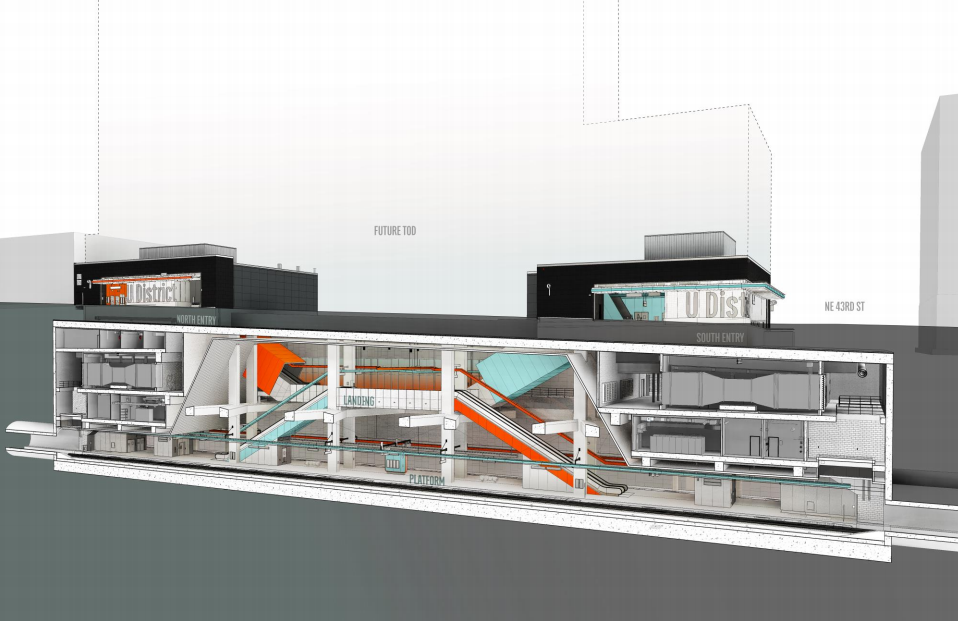
Sound Transit wants riders to intuitively “read” the station. Using different color themes for each station entrance and lobby, riders will be able to associate each space with a specific color. The north entrance will be set off with a bright orange while the south gets a baby blue. Color will appear on roof and wall paneling in lobbies and canopies at the entrances.
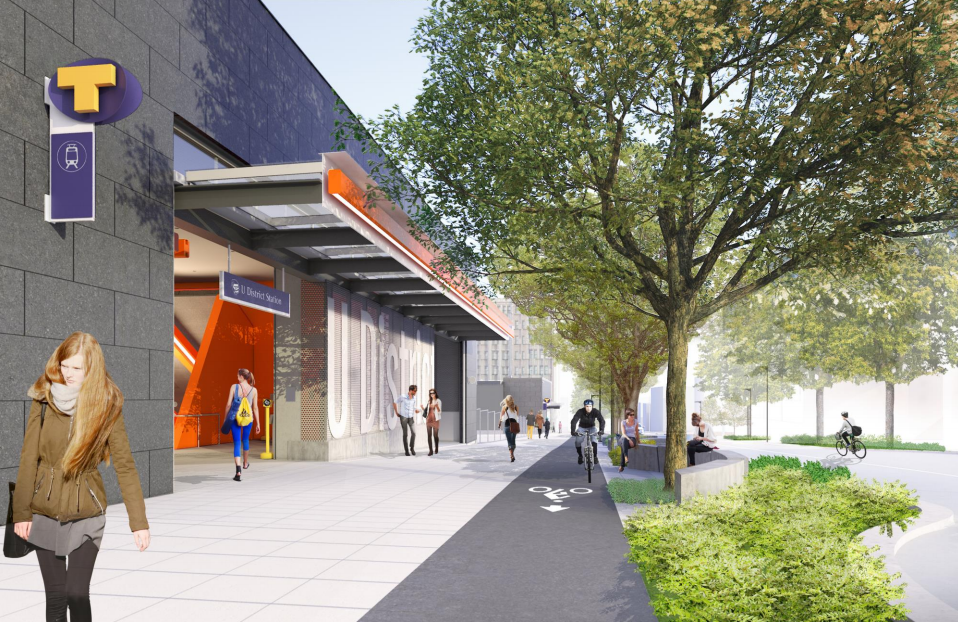
To direct riders to and from entrances and the platforms below, the color theming will continue through the use of overhead hanging ceiling cabinets (light bars) that “light” the way. Reading the station will be most important for people ending their journeys at the station and who want to exit out a particular way. Arriving underground with few clear landmarks can be disorienting, but after a few trips through the station, riders should become fairly familiar with the color–or rather entrance–they want. Signage will also be placed overhead clearly naming streets to direct riders out of the station.
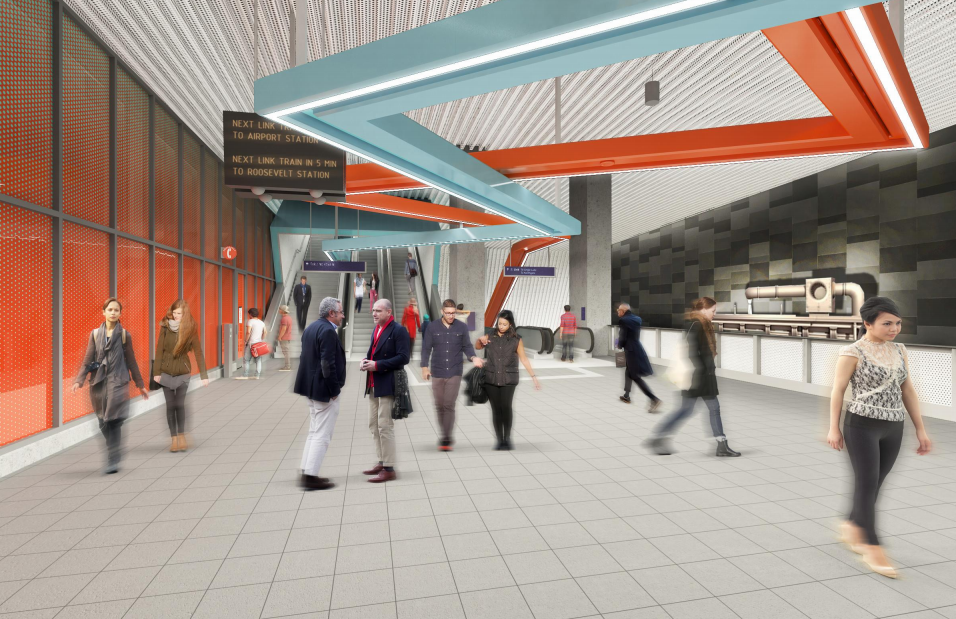
Station Lobbies
University District Station will have two separate entrances and lobbies. The northernmost lobby will be located right next to the Neptune Theatre and designed for only one primary entrance spilling out onto Brooklyn. The entrance to the lobby will be 20 feet wide and offer direct sight lines to UW Tower and the intersection at NE 45th St. A second lobby will be located at the south of the station and designed with two entrances, one on Brooklyn and another on 43rd St. Pedestrians will be able to fully through the space when both entrances are open.
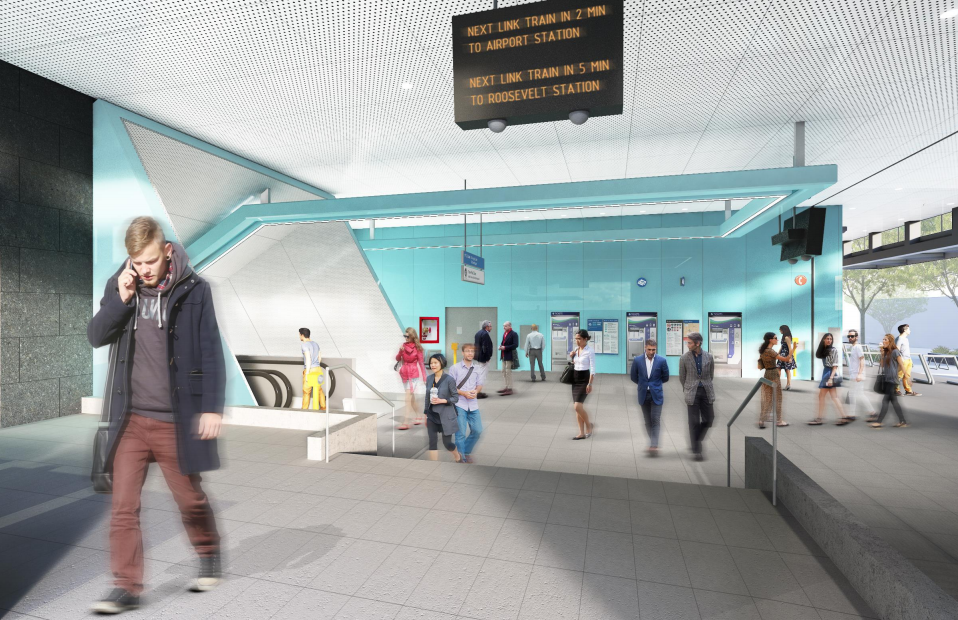
The south lobby will be highly noticeable with its baby blue paneling and dual entrances. But it will also be a very spacious lobby with high ceilings and more overall square footage than its northern counterpart. Riders entering from Brooklyn will walk into a small gathering space and steps that lead to the primary level of the lobby. Just beyond the steps will be a pair of escalators and stairs to the mezzanine level of the station. Ticketing and information kiosks will be located on the opposite end of the lobby and should be immediately obvious to anyone entering the station from the Brooklyn entrance. Real-time information boards will hang down just above the stairs in a conspicuous manner for riders to determine when the next trains north and south will arrive at the platforms below. And to the right, patrons will be able to walk to elevators for easy access directly to the platforms.
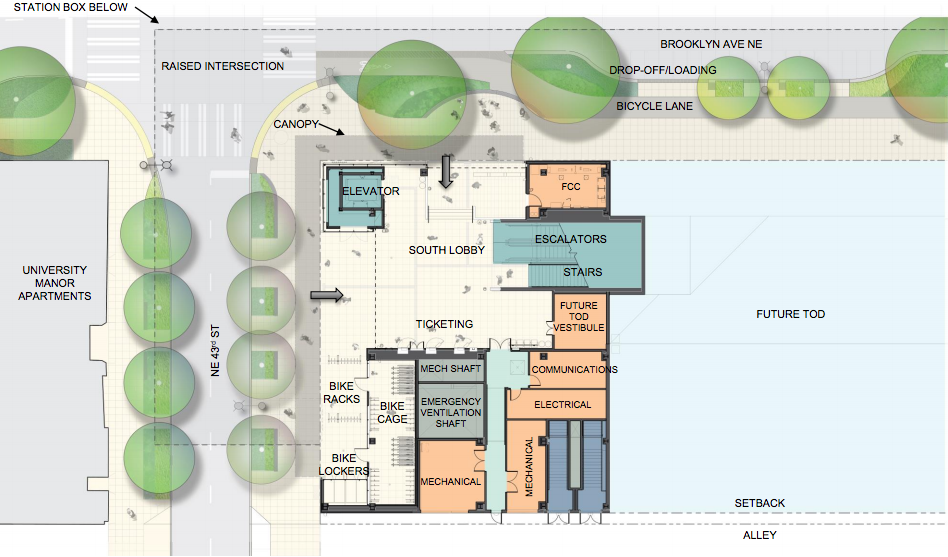
Meanwhile, the 43rd Street entrance will welcome patrons with bike storage areas and easy access to escalators, stairs, and elevators. Real-time arrival information boards, information kiosks, and ticketing will be just as obvious as the Brooklyn entrance, but patrons entering from 43rd Street will be able to split immediately right or left depending upon their needs. The bike storage area will feature a series of racks, bike lockers, and a bike cage.
The bike cage will provide secured, subscription-based locker rooms for bicyclists. The agency is looking into a system that will allow on-demand payment for users based upon the amount of time that their bikes occupy space. If space is available at any given time, a paying user could gain access to the bike cage to lock up their bike. This is different from the standard lockers common at transit facilities; those spaces are dedicated to the sole use of individual subscribers for an entire year. Sound Transit plans to have between 20 and 40 bike parking spaces in the bike cage. Agency staff hope to use a space-efficient approach where bike parking will consist of double-level bike racks that allow two bikes to be parked vertically. Sound Transit project manager Ryan Bianchi had this to say about the approach:
The bike cage model is already readily available in the Bay Area where BART has implemented a similar approach. For instance, on-demand lockers and cages are used by BART: Each on-demand locker has ten users, on-demand cages with 140 parking spots have 3000 users. It’s first-come, first served and a far more efficient use of space than our current secure bike parking.
A new tower is likely to be built upon the site, which is why the design of the south lobby will include a vestibule space. This is intended to provide access directly to the base of the tower and will be available just east of the stairs.
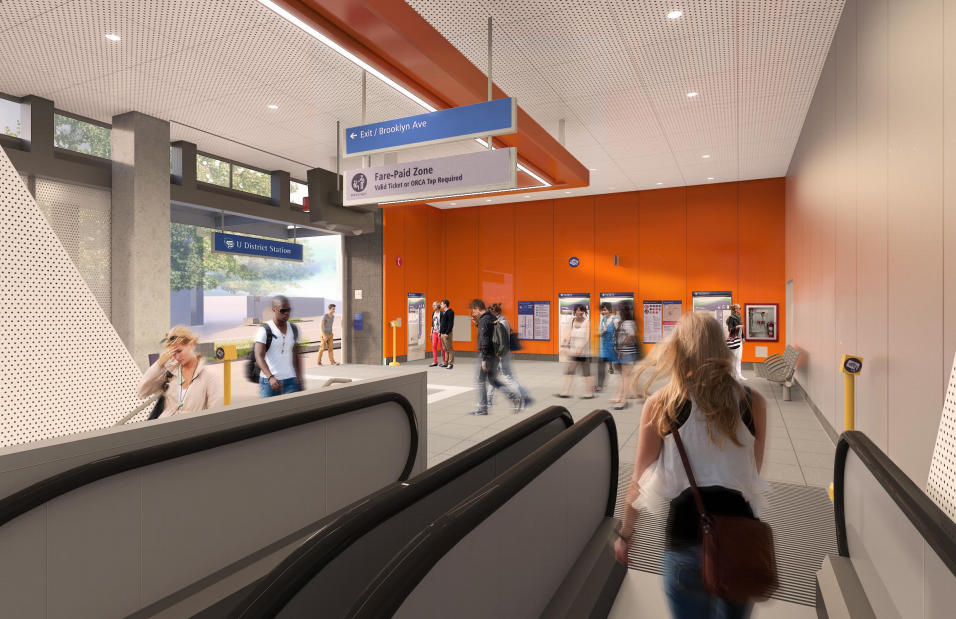
The north lobby will be a lot simpler than its counterpart. The northern lobby wall will have typical station information posted along it and at least four ticket vending machines will be built into it. A lot of “back of house” facilities will be hidden behind the east lobby wall. Riders will see clear signage hanging from the ceilings and a real-time information sign would be situated directly behind the entrance allowing riders to get immediate information about next train arrivals as they enter. An elevator will be located in the southwest corner of the lobby and just beyond it the stairs and escalators to the mezzanine. And extra bike parking will be available behind the elevator, accessible from a separate entrance on Brooklyn.
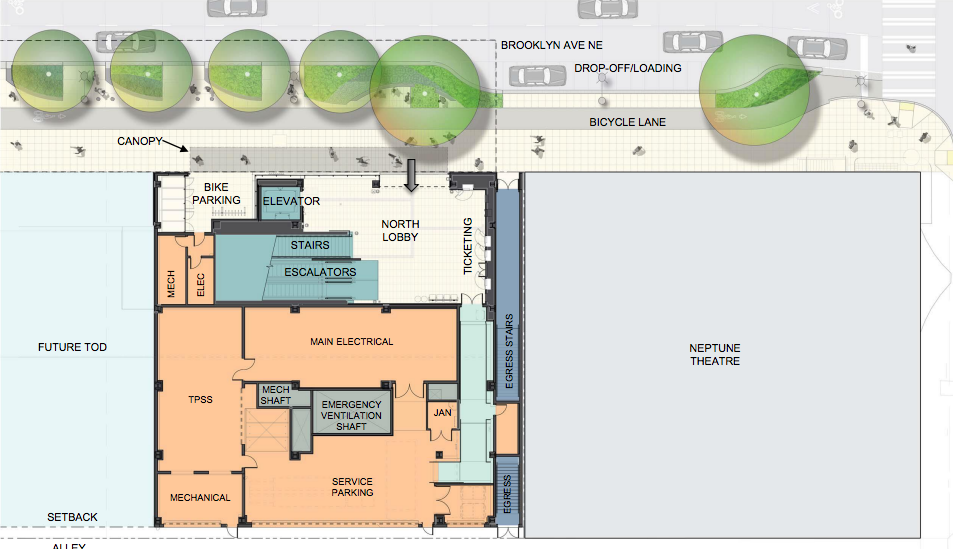
Platform Level
Riders will notice that the platform area has a very open feeling due to the generous horizontal and vertical space. The distance between the platform and station walls is planned to be 22 feet while the platform will be more than 25 feet wide, meaning that the designed cross section from wall to wall will exceed 65 feet. The area above the platform will be mostly open despite the mezzanine. Openings between beams will expose most of the 85 feet separating ground level from the platform, giving riders a pretty extensive view of the walls, where Sound Transit plans to install permanent art features.
Sound Transit is going for a modern aesthetic with large, square but rounded kiosks, checkerboard wall paneling, and more colorful light bars. The large kiosks will post key rider information like the station map and next stops on the line while colored light bars hang from the beams above the platform to tie in with the others in the station, drawing riders upstairs to the lobbies. And wall paneling will contain various grey and brown tones exuding a light textured aesthetic.
Consideration has been given to riders that may be vision-impaired. Not only will prototypical tactile domes line the edges of the platform to warn riders to be wary of what lies beyond, white lines will also be placed on the platform. These will be noticeable to riders who might use canes to guide their way around leading them along the platform and to the information kiosks. For other riders, the hanging real-time informations signs will provide continuous updates about next train departures and pertinent notices.
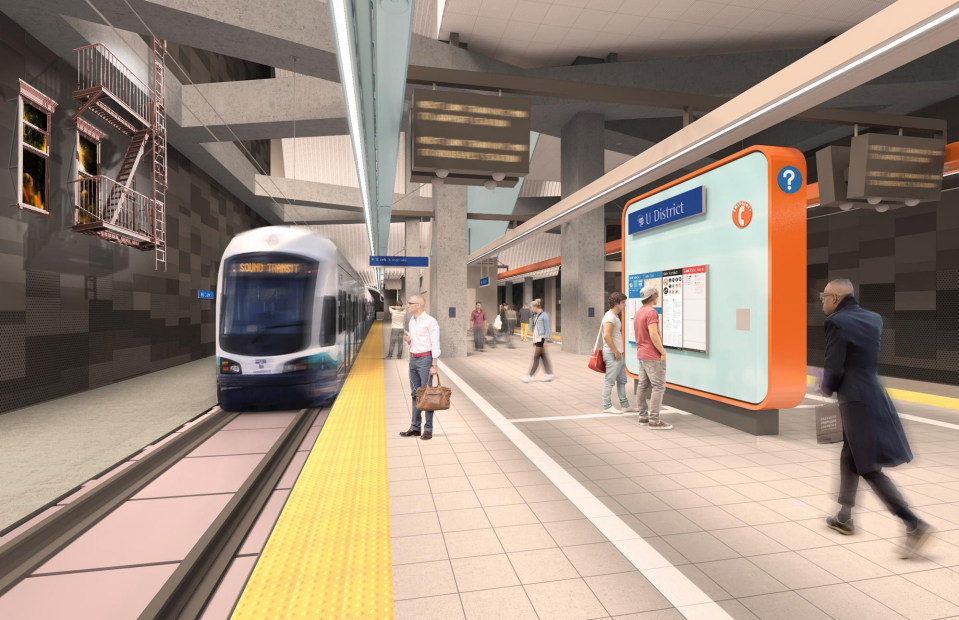
Riders will get to view some incredibly unique artwork that will be visible at both the mezzanine and platform level. Aluminum sculptures will protrude from the wall appearing as windows, architectural ornamentation, fire escapes, and mechanical equipment. The windows will actually be monitors that play video continuously. Runtime of the video is so long that most riders may never see the entirety of it during their collective journeys through the station. Segments of the video are inspired by other art on The Ave and ambient sound will accompany the video as it plays.
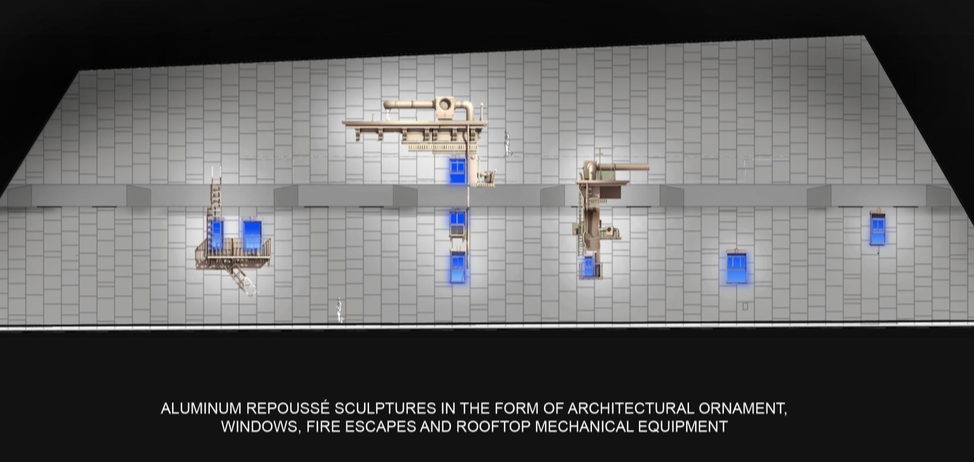
Exterior Building Design
The two head houses are just an interim step in the evolution of the station site. The University of Washington owns the property and intends to build on top of the structures with what will presumably be a tower. Zoning on the site could change in the future allowing building heights of up to 320 feet, so a 20-story plus tower seems like a very real possibility. However, there will be a lag time between completion of the station and transit-oriented development above.
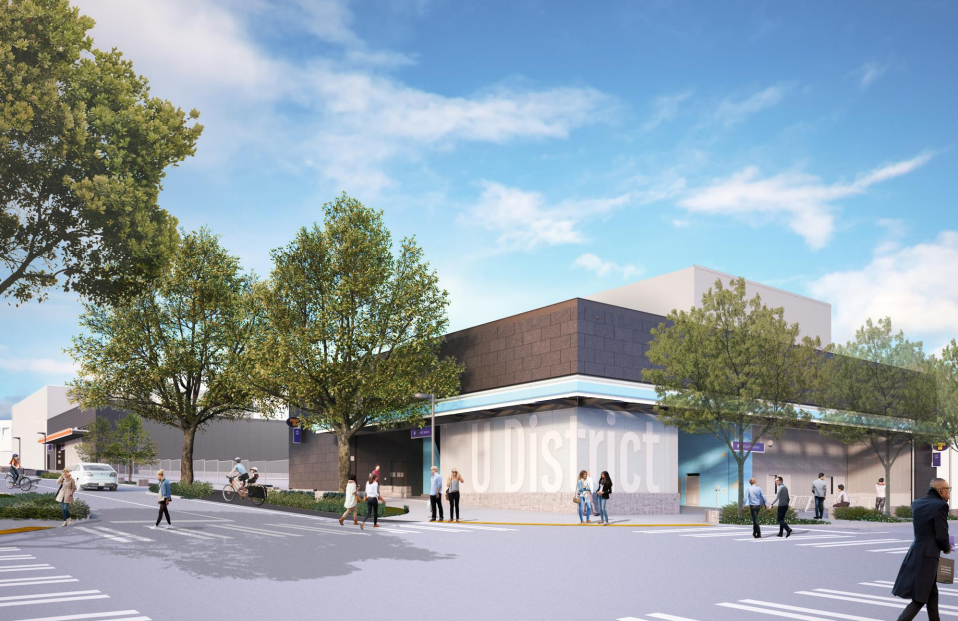
Designers from LMN Architects were intentional with the building material choices and layout of the head house so that they would be compatible with whatever follows but also stand on their own. The words “U District” will be featured prominently on corner of the southern head house. Blacktop brick cap each head house while lower portions of the structures will contain lighter material colors to create a powerful effect so as to grab attention of passerby. The added lobby-specific colors of orange and baby blue will only enhance the effect.
Public Realm Improvements
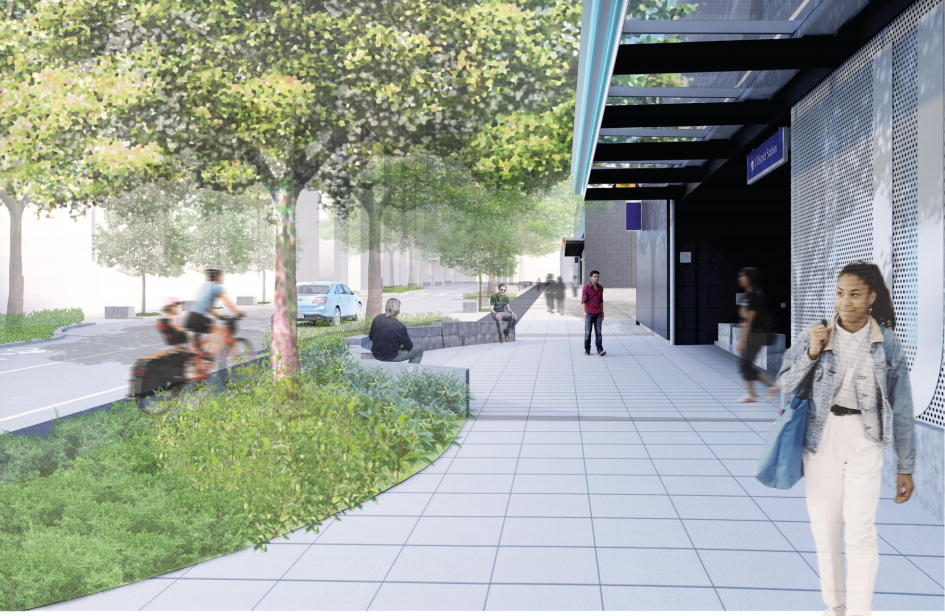
The new station will deliver substantial streetscape improvements to Brooklyn and 43rd Street, including:
- A new mid-block crossing and uphill protected bike lane on Brooklyn:
- A raised intersection and wider sidewalks;
- New bus stops and variable curb extensions; and
- New planter strips and street furniture.
Last year, the City of Seattle formally designated NE 43rd St as a Green Street. Sound Transit is required to implement it through the station project by making improvements to both sides of 43rd Street east and west of Brooklyn Ave Ne. The street will be significantly trimmed down by extending the curbs and improving the sidewalks. New planter strips and street furniture will be installed as part of the improvements. The sidewalk space on north side of 43rd Street will be a full 12 feet wide to give pedestrians ample room to move in and out of the station. Additional space will be allocated to planter boxes and strips. A similar treatment will appear on Brooklyn as well.
The main intersection at Brooklyn and 43rd Street will be a raised surface to match the grade of the sidewalk and protected bicycle lane built into Brooklyn. This design will allow pedestrians to easily flow to any corner the intersection with ease and make the environment a little less regimented for bicyclists. The mixing nature of the raised intersection should serve to slow the speed for all users of the right-of-way and encourage priority of pedestrians. Further north, a mid-block crossing will help break up the two-and-a-half block in half and provide an easy crossing between UW Tower and the station.
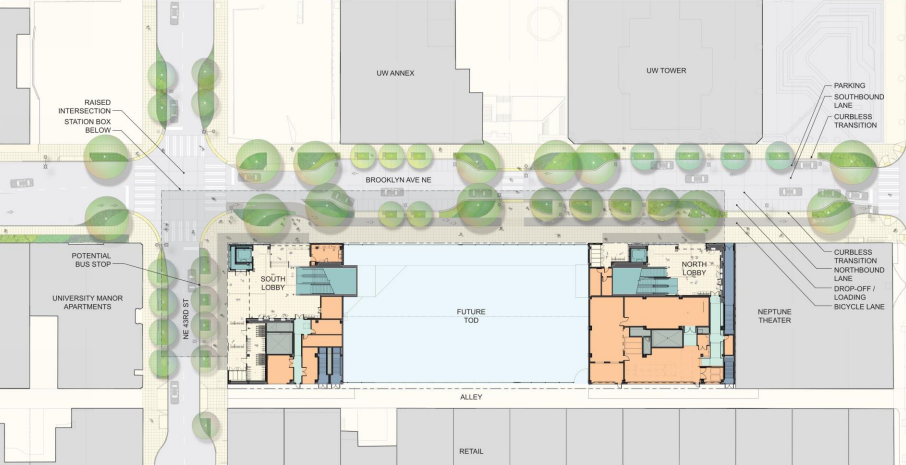
Brooklyn and 43rd Street have been identified as preferred blocks for buses to serve the station. Future alignments of buses passing through the area (e.g., Routes 44, 45, 49, and 70) have yet to be decided, but Metro would like buses to stop in both directions outside of the station. The north side of NE 43rd St has been tentatively chosen as one bus stop location. A bus pullout has also been designated on the west side of Brooklyn to serve buses going the opposite direction.
Parking spaces will be accommodated along portions of Brooklyn and a specific load and unload area will be designated for the Neptune Theatre, a popular venue for musical artists and comedy acts.
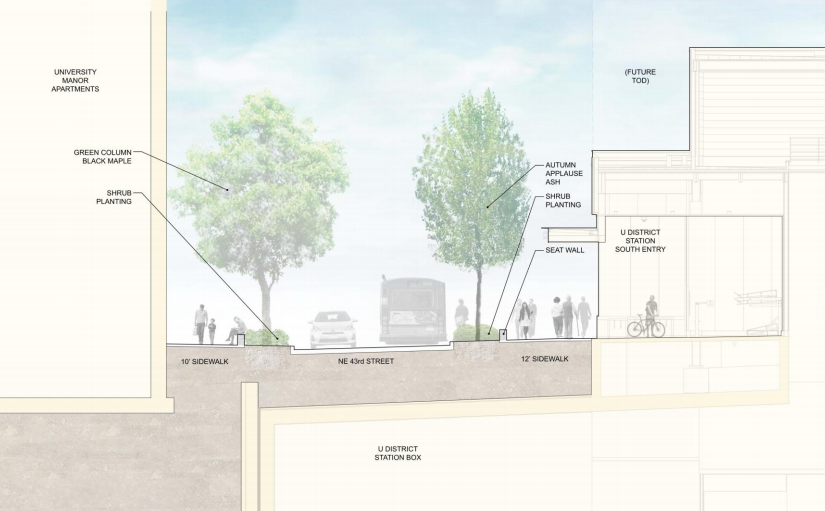
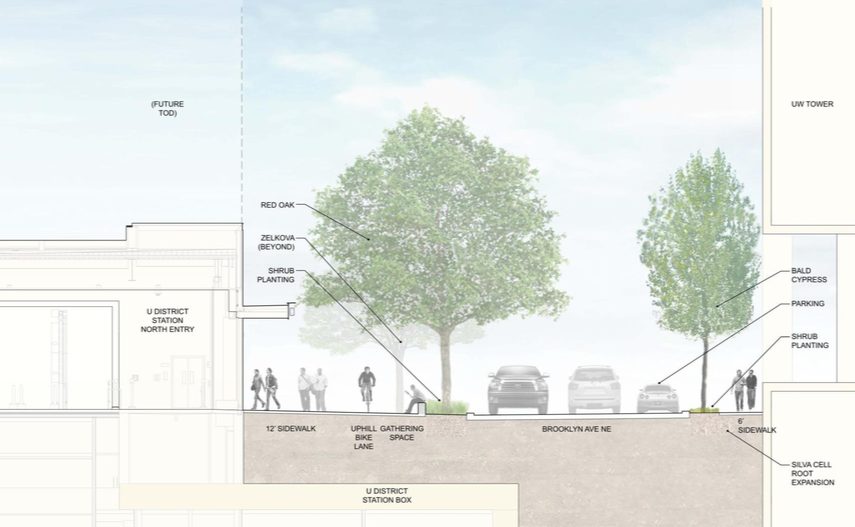
Notably, Sound Transit will construct an uphill separated bike lane on the east side of the street. But no comparable bike facility will be offered in the downhill direction. Instead, sharrows will be painted for southbound travel. Bicycle advocates will decry this as a missed opportunity to provide completely separated bicycle facilities on Brooklyn, but Sound Transit says that the street simply has too competing uses and a lack of right-of-way width to work with.
A smattering of other bicycle facilities are located in close proximity to the area, including:
- 12th Ave NE (a block to the west of the station) which is formally designated as a Greenway;
- Roosevelt Way NE which has a one-way protected bike lane (PBL) that recently opened (and 11th Ave NE which is planned to eventually complete a PBL couplet on the corridor); and
- Bike lanes that reach as far north as NE 41st St on Brooklyn and continue south to NE Pacific St to intersect with other bike facilities on NE Campus Pkwy, NE 40th St, and the Burke-Gilman Trail.
Despite these bicycle facilities in place, there are serious gaps in the bicycle network between the station and them. In an ideal world, all of those bike lanes would meet the station head-on as either regular bike lanes or protected bike lanes, and perhaps the gaps will be filled in over the coming years, but they won’t be a part of the off-site station improvements.
What’s Next
Sound Transit is still billing the station to open in September 2021, but there is substantial project float that could allow a much earlier opening date. As of the last agency progress report, the project float stands at more than five months, suggesting that an April 2021 opening isn’t out of the cards. And if progress continues without too many hitches, that float could expand even further. Regardless, University District Station will be the next station to come online in the Central Link system so there is much to look forward to.
The title image is courtesy of Sound Transit, LMN Architects, and Swift Company.
Stephen is a professional urban planner in Puget Sound with a passion for sustainable, livable, and diverse cities. He is especially interested in how policies, regulations, and programs can promote positive outcomes for communities. With stints in great cities like Bellingham and Cork, Stephen currently lives in Seattle. He primarily covers land use and transportation issues and has been with The Urbanist since 2014.


